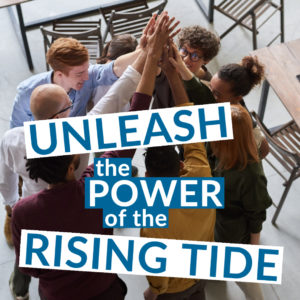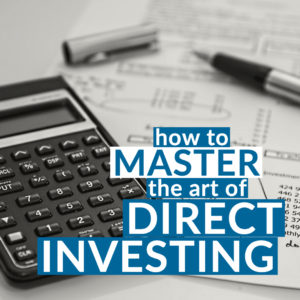Coronavirus is impacting business in new and unprecedented ways. Just look at these initial jobless claims from the US Department of Labor!
Stay tuned for our thoughts on how this will impact your business and what you can do about it.

The way you see yourself and the world around you determines how you interact with both. Your perceptions shape your reality at every level and in every single aspect of your life. As a result your perceptions have a powerful impact on your effectiveness and fulfillment in life. This is even more accentuated for leaders. This is why taking control of how you choose to see yourself and the world around you is so important. Often we have to choose between competing perspectives, and these decisions can permanently alter the quality of our lives. One of these important decisions is in the mindsets frequently referred to as “zero-sum” and “rising tide.” A quick summary of these two opposing philosophies: Zero-sum: this is the idea that if you win someone else has to lose. This belief is predicated on the belief that there is a limited amount of any resource and thus it can only be divided up so much or go so far. An example of this occurs when you purchase a pie. In a zero-sum vision of the world, you love pie, and you want as much as possible. You want to get as much for yourself as you possibly can. That is, you want the biggest slice of pie that you possibly can get. The zero-sum perspective is also sometimes called the scarcity mindset. The panic to get as much as possible comes from the belief that when this resource is gone, there is no more to be had. Rising tide: this is the belief that a rising tide lifts all boats. That is, in a positive economic environment, everyone makes money and everyone does well. The rising tide mentality allows for the possibility of multiple winners in a game, or an economic event. When one person wins, others often can and do win as well. In this case, one person’s success does not necessarily have to come at the expense of someone else. In the rising tide mentality, there is the belief that as one person wins it actually creates opportunities for others to win too. Why rising-tide is superior Sometimes it seems like there is no tangible limit to what can be accomplished when the rising tide model is applied. Sure, sometimes there most definitely is a tangible limit on a particular resource. For instance, there are only so many Dali paintings, and there is only a certain amount of oil available to be extracted from the earth. However, you should start with the belief that there has to be a win-win solution to a perceived potential conflict for resources. This forces people to apply a little creativity and ingenuity. When we do this, we often allow everyone to look at the puzzle a different way, and utilize more resources or see more value from a different angle. This prompts us to see the situation in a new way. A new perspective can reveal solutions that a zero-sum mindset would simply never unleash. In short, the Rising Tide mindset is built on the belief that there’s no limit to the amount of gain any one person can obtain. And the most important distinction: any gain does not have to come at another person’s expense. Rising tide & pie So let us re-examine the pie example. In a rising-tide philosophy, the idea is that the pie just keeps growing or, more realistically, you can just keep making more pies until everyone has been fed. The ultimate conclusion here is that there is no reason to hoard or take from others. This is why the Rising Tide idea is also sometimes called an “abundance mindset.” This is choosing to adopt the perspective that there is enough for everyone, and there is a place for everyone. As Profit is made, the economic pie grows over time and does not disappear as people make profit. Sure, all of this is super -philosophical and heady. So why does it matter, and how does it impact our work buying and selling companies? Let’s take a look at how life turns out when you make decisions from either one of these two perspectives. Zero-sum desolation I’ve observed that people utilizing the zero-sum mindset typically miss opportunities, burn bridges, and create adversarial relationships. The zero-sum mindset thus typically produces personal isolation, emptiness, a lack of fulfillment, and scarcity in multiple parts of life. Unfortunately, this scarcity is often especially created in the things that really matter in life. Picture the parent who yells at the referee from the sidelines of a youth soccer game. They might be driven by the belief that winning is the only object, and that winning is important only if their child has an exceptional game. They are driven by the belief that everything hinges on the experience had by their own child and that is all that matters to them, not necessarily how well the team plays together. Their boorish sideline behavior can ruin the experience for everyone else. Later, people will turn away from him when he enters the Dairy Queen after the game. Admittedly, a zero-sum approach does not guarantee failure. In fact, a lot of zero-sum people have found success in business, which can reward this behavior, and thus they cling to this approach. However, when you look closely, you will begin to see that many “successful” people are unfulfilled or angry or just all alone. Maybe it’s because they gained their success at the expense of others and now they have no one left to enjoy it with. Rising tide celebration Rising tide mindset typically creates new and unexpected opportunities, additional connections, and giving or nurturing relationships. The rising tide mindset typically produces trust and deep friendships, personal fulfillment, and an abundance of the things that actually matter. Picture the parent on the sidelines again. Only now he is cheering his daughter while also celebrating the performance of other children in her team … and even on the opposing team! He still wants his

When it comes to making direct investments, it’s critically important to ensure that the Investment structure itself aligns interest between the investors and the business founders or managers. That is to say, you have to structure the investment as a win-win. Now “win-win” is a term we have all heard in various contexts. But you are probably asking; what does it mean, exactly, in an investment structure? Is it just about making money? Here’s what win-win means for each part of the venture. Win-Win means: Each party should receive an appropriate gain. A business succeeds because the investors’ contributions of money and resources, and the managers’ investment of time and experience. Therefore, the gains that are realized should account for both of these factors. Interests are Aligned. It ensures that returns are balanced and fair between operators, leaders, and investors. This fairness is based upon their respective contributions. Considers the contribution required for success. Look at the efforts and energies applied to achieve milestones, and overlay those with the free cash flows from the business. The structure that makes the most sense should provide an appropriate upside for all parties involved based upon the business needs to achieve those milestones. At the end of the day you want to make sure the investment structure reinforces trust between all parties to ensure decisions are made that benefit everyone. Why do win-win investments matter? A win-win structure facilitates a partnership mindset that allows everyone to operate with a more collaborative or a “rising tide” structure. This creates more value for everyone over the long run. Here are some other reasons that win-win structures matter: You don’t want to burn out operators. That could lead to an ongoing conflict of interest between investors and managers or leaders which translates to potential bad behavior or legal exposure. Misaligned structures create built-in conflicts of interest. They also encourage short-sighted decision making. Everyone will get better results with a more collaborative structure and a long-term mindset. Operators will be able to make decisions with confidence, knowing others have their back. Investors can trust that the operators or leaders are acting in their best interest when everything is aligned correctly. How to create win-win structures There is no baseline, normal structure or one-size-fits-all approach to achieving a win-win structure. This is really where experience and understanding the business should help. A veteran leader or arbiter can facilitate a candid conversation between investors and operators or leaders. At the end of the day, the primary metric is money. When making specific determinations, consider the following: Are the operators are leaders receiving a base paycheck? Do the operators and leaders have some kind of bonus or performance incentive? Does that incentive align investors interests? Are investors seeking a minimum return in the form of some kind of preference, like returning investment capital prior to operators receiving dividends disbursements? Also, you should consider other non-monetary aspects and contributions within a given partnership. That list is long, but it includes time demands and non-monetary benefits. Of course, these vary based upon the business, but you should keep an eye out for these other factors when you’re structuring a deal. All of these things add up to create the required elements for a business to achieve milestones and become successful. Have challenging conversations to create win-win scenarios When it comes to having conversations with operators and leaders, there are some specific things that investors can do to lead things along. First, determine exactly what you, as a potential Investor, need or want prior to negotiating with the operators. This may require several initial meetings with everyone involved to ensure that you have an accurate understanding of the parameters. Second, identify and distill your risks and the return you would like to see from your investment. Based upon this return on the risks you feel you would be taking. Finally, make a point to invest the time to understand the other party’s needs. This includes things like investigating their concerns and finding out what monetary and other factors are important to them. These requests might have a minimal impact on you, and reveal a way that you can give them a win along the way to establish rapport. After you’ve considered these three factors, you are then ready to sit down and have the real investment negotiation. The win-win negotiation The win-win negotiation has required discussion points. Failing to surface these ideas and concerns runs the risk of derailing the partnership or – worse yet – setting everyone up for a bad experience that ends in financial damage. Most importantly, it is crucial to speak with candor and to press for the same from your potential business partners. Use the following steps to help guide you to a more fruitful conversation. Begin the win-win negotiation with an honest conversation about each party’s interests or needs. Talk openly about what you can do to build a partnership foundation. Discuss and evaluate or adjust the structures collaboratively. Define terms that allow all parties to achieve desired outcomes. There is no one-size-fits-all solution, nor is there a silver bullet to align investment structures. The reality is; there are a ton of different factors to consider when investing and these are only a few of the factors that are not commonly discussed. We love to go into every detail at Transfigure and have a lot of experience putting these types of structures in place on both sides of the table. We frequently advise investors and operators or leaders on these type of transactions, always emphasizing the importance of covering all the bases in a candid, thoughtful way, to build successful partnerships. If you’d like us to take a look at your deal and just give us give you your two cents, we’d be happy to do that. Visit our site to arrange a free consultation.

To state the obvious; Everything is Changing! This current COVID-19 / Coronavirus situation and the need to minimize in-person social interactions brings with it some big changes to daily routines for everyone. With the onslaught of online content that is already giving all kinds of obvious solutions and ideas, like the obvious virtualization tools and plans, we wanted to offer up a few non-obvious ideas to help you weather this season. One of the most important things to avoid while Social Distancing is allowing yourself to become Isolated. That is; Isolated from the friends and family that bring fulfillment and joy to your life. Isolation from the business connections and colleagues who engage your intellect challenge you to grow. Take charge and make sure you avoid personal isolation! Here are a few specific things you can do to ensure you avoid isolating while social distancing: Help/Serve Others When you are by yourself for long periods of time, it is easy to get consumed by your own troubles, anxieties, and fears. This leads to a dangerous self-centered focus that can quickly turn into some very negative behaviors and habits if you are not careful. Instead, take control of your mindset. Find ways to help and serve other people. As counterintuitive as it may be, helping or serving others is one of the best ways to overcome your own challenges. Practice gratitude Take a few minutes to stop and make a list of things and people you are thankful for. This small practice is a subtle way to train your subconscious to pay attention and even look for the positive around you. As a bonus; when a person you are grateful for comes to mind, stop and send them a text or email to tell. It does not have to be anything complicated or extravagant. Just a simple “I’m grateful you are in my life. Hope you are well!” is all it needs to be. Create A Routine On the more practical side of the spectrum, create a regular routine during your time at home. This will help break up the monotony and give you something to look forward to. Go ahead and keep that morning alarm set. Maybe push it back an hour or two, but set a time to get going for the day. Schedule a regular call with friends or work colleagues just to keep in touch. Exercise There are all kinds of simple and easy exercises that you can do at hope whether you have any exercise equipment or not. Even the most basic exercise helps get the blood flowing and will help your mental outlook, strengthens your immune system, and will help you feel like you accomplished something for the day. Get Outside Go for a walk. If it is appropriate and safe where you live, go get some fresh air and a little exercise. Maybe shovel the snow from your driveway, or even just a brisk walk. I know, this is not necessarily a means to interact socially or prevent isolation, but the fresh air and the little bit of exercise will go a long way in helping to improve your mindset and mental outlook. Join Online Groups There are TONS of great Facebook and LinkedIn groups out there. Look for a few that catch your eye. Go ahead; join, engage, see who you can connect with online One (somewhat) selfish plug; We created a LinkedIn Mastermind group specifically for Business Owners and Leaders. Check it out and join here: https://www.linkedin.com/groups/13843549/ Engage on Social Media If you are anything like me, I have a hard time doing anything other than checking social media highlights every now and then. I have engaged only a little bit with comments and other social media interactions. Now is a perfect time to comment and engage! Remember: Life will go on! As we started this post, everything is changing. There are going to be all kinds of long-term implications and changes from this experience. But, fight to keep a positive outlook and be creative to engage with the world in a new way! We got this!

Entering the world of direct investment can be both exciting and intimidating. This change is especially challenging when your background includes operating and managing businesses. One of the hardest aspects of this transition to the Direct Investing world is transforming your mindset. You see, to be successful as an investor, you first have to start thinking like an investor. Start thinking like an investor, stop thinking like a manager If you have been a manager or a business owner, you are likely coming from a mindset of acting, doing, and creating, with the goal of making money. However, at its core, direct investing is not about making money. Direct investing is the art of avoiding loss. Adopting this mindset is the first step in your transition. The next step is looking for investment opportunities that fit for you. This is where the real work happens. On the investment side, there are some specific things that you can do to make investment decisions more quickly and with greater confidence. Define targets and criteria for yourself around the kind of investments are the best fit for you. Base this on questions that examine your experience. What is your background? What industry knowledge or expertise do you have? What perspective did your position(s) give you to answer complex questions? Answering these questions unleashes your personal unfair advantage when investing in that industry, business, or market. This creates your first filter, providing you with some guidance on where to look for investment opportunities. However, to fully evaluate investment deals, you need to examine these 4 attributes: Attribute 1: A business model you understand in an industry where you have experience Look for companies that operate using a business model you understand in an industry where you have experience. All businesses operate in one of two business models, both of which are perfectly viable approaches to any industry. They’re either Differentiated, meaning they provide a better product or service at a higher price, or they’re Cost Competitive, meaning they compete by providing a product or service at the lowest cost to customers. Both business models are viable and definitely work. As a side note, at Transfigure we prefer businesses that operate using a differentiated model. Under this approach, margins are typically higher and more consistent. The important thing to evaluate is that the managers and operators understand the model that they’re using for their business. Are they applying strategies that are consistent with that business model? If the business has a strong brand and focuses on providing a superior product using a differentiated model, they should not have to rely on substantial discounting to grow their business. If they are applying a cost-competitive strategy, it is not consistent with their model, it might be a warning sign. So make sure you understand the strategies they are using and ensure they align with the business model. The other factor here is leveraging your industry knowledge and experience. This allows you to have more insights into trends, the future of the industry, or the market. Focus on understanding or applying your knowledge and expertise to determine where the industry is heading. What disruptive changes are likely on the horizon? What opportunities does this create? How can you partner with operators to recognize value from these changes? Now, investing in businesses or industries you are very familiar with is a balancing act. You need to be careful because familiarity can create blind spots. This is especially true when it comes to identifying disruptive changes – the kind that create explosive or transformative growth. Attribute 2: A sustainable competitive advantage Look for businesses that possess a sustainable competitive advantage. These are businesses that have the ability to change prices with minimal impact to sales or revenue. An easy example would be looking at brands like Coke or Nike. Each of these companies have a loyal customer base. They can charge a premium for their products or change prices relatively easily. So you’re looking for advantages that help your target business reinforce their position within an industry or market. Of course, they do not have to be the same size as Coke or Nike – those companies are well established. However, you can look for and find smaller businesses within certain markets that operate with similar competitive advantages. The point is to look for businesses that are considered best-in-class within the markets you’re exploring. It’s actually fairly common for small businesses to possess that kind of advantage when it comes to customer service and attention. This is because the owners are involved on a day-to-day basis. This brings up a related point. With small and growing businesses, it is critical to examine closely whether the market or competitive advantage is driven by the work of just one person at the company. If it is, that’s not necessarily bad or a deal breaker. However, you need to identify a clear path for them to expand this advantage beyond just that one person. Attribute 3: A competent and honest management team As an investor, it is crucial that you look for competent and honest management teams at the companies where you plan to invest. You want a management team that genuinely has a partnership view with investors. This ensures that interests are aligned on all levels Here are some proven indicators of an honest and competent management team: Clear and accurate communication, Exhibited partnership mindset, Solid understanding of where value is created and captured, Managers who are respected by their employees. To explain #3 above, you want your management team to have a firm grasp on the unit economic staff, team dynamics and skills, competitive differentiation, and the strategies that pull everything together. For #4, managers and operators should have an accurate understanding of many aspects of the work. They should know the market landscape, the competitors, market influences and drivers, client and customer demands and needs, and shifts in the industry. At the end of the day you want to
Complete the following form and we’ll reply right away with the Business Value Calculator and our 5 Tips to Maximize Business Value.
You’ll also be subscribed to our email list and receive the most up to date info from Transfigure to help you grow your business.